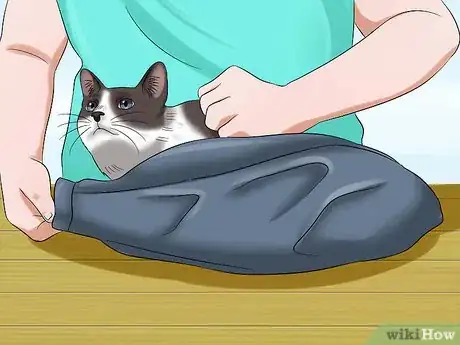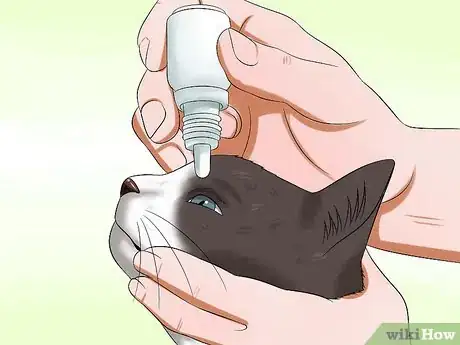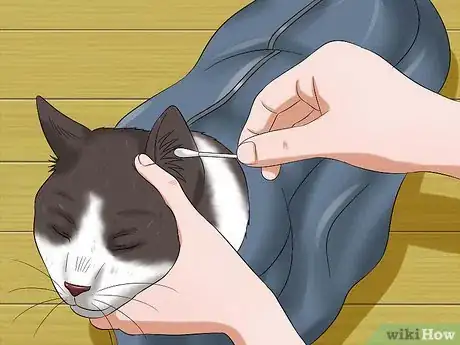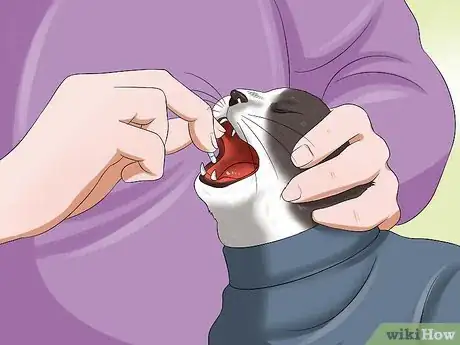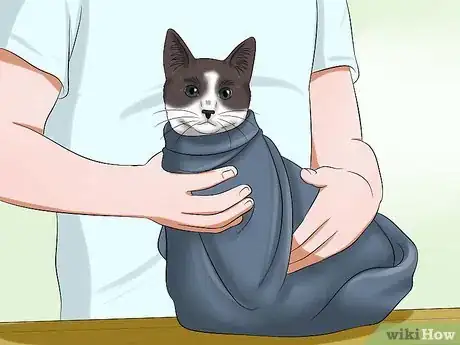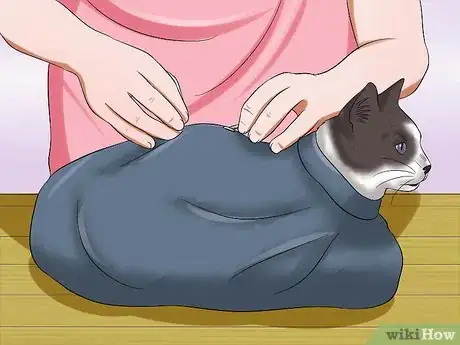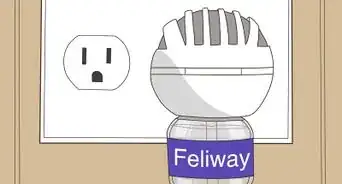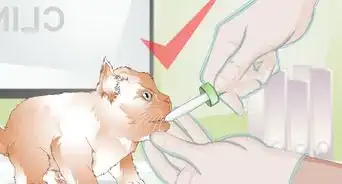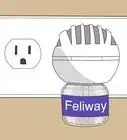This article was co-authored by Pippa Elliott, MRCVS. Dr. Elliott, BVMS, MRCVS is a veterinarian with over 30 years of experience in veterinary surgery and companion animal practice. She graduated from the University of Glasgow in 1987 with a degree in veterinary medicine and surgery. She has worked at the same animal clinic in her hometown for over 20 years.
There are 9 references cited in this article, which can be found at the bottom of the page.
This article has been viewed 62,091 times.
Although cats are domesticated animals, they can be uncontrollable when they panic. Do not try to hold onto a cat with your hands if she becomes forcefully resistant to restraint. A sturdy fabric bag makes a good emergency cat carrier and can do wonders to calm the cat, keep her safe, and keep you safe, too. A cat comfort bag, also known as a restraint bag, can make it possible to medicate, examine, treat, and restrain almost every cat, even feral ones.
Steps
Putting a Cat Into a Comfort Bag
-
1Purchase a comfort bag. Comfort bags are designed to hold a cat comfortably and allow you to safely access different parts of her body, depending on what you need to do (e.g., trim her nails, put medication in her eyes or ears). They are typically made of thick canvas or nylon, and have various openings to access the different body parts.[1]
- Cat comfort bags are available online and at your local pet store.
- In general, there is a neck opening that can be loosened and tightened and a long zipper that runs down the middle of the bag.
- Although all cat comfort bags generally work in the same way, there may be specific design variations. Talk with your veterinarian if you are unsure how to decide which one would be best for your cat.
-
2Place the comfort bag’s neck opening over your cat’s head. Putting your cat in a comfort bag can be challenging, so do not be surprised if your cat is not exactly a willing participant in the process. The first thing you will need to do is get the bag over her head. With your cat sitting on a table or other flat and sturdy surface, loosen the neck opening of the bag and slip her head through the opening.
- The rest of the bag should be hanging loosely down her back.
- Make sure the long zipper is unzipped before putting your cat’s head through the neck opening.
Advertisement -
3Fasten the neck opening. The specifics on fastening the neck opening may vary from one bag design to the other, but the general idea is to tighten the opening so your cat cannot wiggle one of her legs through it. Do not tighten it too much, though! Your cat may have trouble breathing if you make the neck opening too tight.[2]
- Test the tightness of the neck opening by putting one finger into the opening. That one finger should fit easily, but snugly, through the opening.[3]
- Adjust the opening accordingly if it is too tight or too loose.
-
4Zip up the long zipper. With your cat’s head secured, either flip her on her back or lift her up (without flipping her on back) to zip up the long zipper that runs the length of the bag. You may have to try both ways, depending on how resistant your cat is to being put in the bag. Gently maneuver her legs and tail into the bag, which may be a little tricky if your cat is particularly squirmy.
-
5Try an alternative method of putting your cat in the comfort bag. If draping the bag over your cat’s neck isn’t working, you can try putting the rest of her body in the bag first. Put the bag on the table with the long zipper open, and put your cat in the middle of the bag.[6]
- Gently tuck her legs and tail into the bag, pull up the sides of the bag around her, and zip her up with the long zipper running the length of her back.[7] Once again, be careful not to get her fur caught in the zipper.
- With her body snugly in the bag, drape the neck opening over her neck and tighten.[8]
Performing Procedures With Your Cat in the Comfort Bag
-
1Trim your cat’s nails. With your cat snugly in the bag, you will probably have an easier time trimming her nails. Depending on the design of the bag, you may have to unzip a small zipper to open a small access hole through which you will pull one of your cat’s legs.[9] Touch and massage your cat’s claws to relax her before you start trimming her nails.[10]
- There are different options for nail clippers, including human nail clippers, and pet-specific ‘guillotine’ or ‘scissor’ style clippers.[11] Use whichever type you are comfortable with.
- Take your cat’s paw in one hand and gently squeeze with your thumb and finger on the joint just behind the nail to extend the nail.
- Trim just the tip of the nail. This will prevent you from accidentally cutting the quick, which would be very painful for your cat and cause the nail to bleed.[12]
- If the nail starts to bleed, dab the tip of it in some cornstarch or styptic powder (available at your local pharmacy).[13]
-
2Give your cat eye drops. Cats do not like things going in their eyes,[14] so having your cat safely restrained in the comfort bag will make the process go a little more smoothly. Hold her in your lap, with your non-dominant arm draped across her body, to make her feel more comfortable.[15]
- Cup your cat’s head in your non-dominant hand, with your thumb and other fingers under her lower jaw. Tilt her head upward. [16]
- Pull the bottom of the eyelid down with the thumb of your non-dominant hand.[17] Administer the prescribed number of drops into her eye,[18] making sure not to touch her eye with the applicator tip.[19]
- Give your cat a treat after you give her the eye drops.[20]
-
3Clean and medicate your cat’s ears. To handle your cat’s ears, hold her in lap as you would if you were giving her eye drops. Wrap your non-dominant hand around the side of your cat’s head, opposite of the ear you want to work on. Use the thumb of that hand to hold down the ear. To clean the ear, use the ear cleaning solution recommended by your veterinarian.
- Squeeze some drops onto the inside of the earflap, as well as down into the ear canal. Your cat may start shaking her head, creating a mess as the solution flies out of her ear.
- Gently massage the base of your cat’s ear with your thumb and index finger to ensure the solution reaches down into her ear.
- Use a cotton ball to gently swab the inside of her ear to remove any debris or discharge.
- To medicate her ears, use the same method as you did to clean her ears. Make you give the medication after her ears are clean.
-
4Administer oral medication to your cat. Having your cat in a comfort bag will make it a little easier to give your cat a pill, but be aware that she could still try to bite you. To give her a pill, position her such that her body is facing away from you. Place your non-dominant hand on top of her head, with your thumb and fingers facing down on either side of her to keep her head still. Tilt her head upward.[21]
- With your dominant hand, hold the pill between your thumb and index finger and use your middle finger to pull down on her lower jaw and open her mouth.[22]
- Once you have her mouth open, quickly place the pill as far back on the center of her tongue as you can manage without getting bitten. Hold her mouth closed and rub on her throat to get her to swallow the pill.[23]
- Don’t be surprised if she spits the pill back out. You can keep trying if your cat isn’t biting you.
Taking Precautions When Your Cat is in the Comfort Bag
-
1Stay with your cat when she is in the bag. You may be safely out of harm’s way—mostly—with your cat in the bag, but that does not mean you should leave her to her own devices. For example, if you fastened the neck opening too tightly and your cat begins to struggle, she could make it very difficult for herself to breathe. Plus, if she’s clever enough, she may be able to figure out a way to poke a leg through an opening.
- It is very important that you not leave your cat unattended when she is in the comfort bag.[24]
-
2Remain cautious when your cat is in the comfort bag. Keep in mind that you are not 100% safe from bites and scratches when your cat is in the comfort bag. She could still bite you if you are giving her oral medication, and she may even try to take a swipe at you if you have one of her legs out. Even when restrained, your cat will still have her self-preservation instinct, and will try to do anything she can to protect herself.[25]
- Letting your guard could result in you getting scratched or bitten.
-
3Adjust the tightness of the comfort bag as needed. Comfort bags are extremely useful, but only when they are used properly. If the bag is too tight, your cat could start panicking. A bag that is too loose would not restrain your cat enough. If you are using the comfort bag for the first time, pay close attention to how well your cat is restrained and make adjustments accordingly.
- Your cat may not like being in the bag, but she may tolerate it more if she’s comfortable when she is inside of it.
Warnings
- Because of your cat’s self-preservation instinct, your cat may try to bite or scratch you while you try to put her in the comfort bag.⧼thumbs_response⧽
References
- ↑ https://www.vetinfo.com/how-to-use-a-cat-restraint-bag.html
- ↑ https://www.vetinfo.com/how-to-use-a-cat-restraint-bag.html
- ↑ https://www.vetinfo.com/how-to-use-a-cat-restraint-bag.html
- ↑ https://www.vetinfo.com/how-to-use-a-cat-restraint-bag.html
- ↑ https://www.vetinfo.com/how-to-use-a-cat-restraint-bag.html
- ↑ https://www.vetinfo.com/how-to-use-a-cat-restraint-bag.html
- ↑ https://www.vetinfo.com/how-to-use-a-cat-restraint-bag.html
- ↑ https://www.vetinfo.com/how-to-use-a-cat-restraint-bag.html
- ↑ https://www.vetinfo.com/how-to-use-a-cat-restraint-bag.html
- ↑ http://www.aspca.org/pet-care/virtual-pet-behaviorist/cat-behavior/trimming-your-cats-claws
- ↑ http://www.humanesociety.org/animals/cats/tips/trimming_cat_claws.html
- ↑ http://www.humanesociety.org/animals/cats/tips/trimming_cat_claws.html
- ↑ http://www.humanesociety.org/animals/cats/tips/trimming_cat_claws.html
- ↑ https://www.medicanimal.com/3-Steps-to-Correctly-Administer-Eye-Drops-to-Your-Cat/a/ART111471
- ↑ http://www.vetmed.wsu.edu/ClientED/cat_eyes.aspx
- ↑ http://icatcare.org/advice/how-guides/how-give-your-cat-eye-dropsointment
- ↑ https://www.medicanimal.com/3-Steps-to-Correctly-Administer-Eye-Drops-to-Your-Cat/a/ART111471
- ↑ https://www.medicanimal.com/3-Steps-to-Correctly-Administer-Eye-Drops-to-Your-Cat/a/ART111471
- ↑ https://www.vetinfo.com/give-cats-eye-drops.html
- ↑ https://www.vetinfo.com/give-cats-eye-drops.html
- ↑ http://icatcare.org/advice/how-give-your-cat-tablet
- ↑ http://icatcare.org/advice/how-give-your-cat-tablet
- ↑ http://icatcare.org/advice/how-give-your-cat-tablet
- ↑ https://www.dvm360.com/view/photo-gallery-how-make-cat-restraining-bag-step-1
- ↑ https://www.dvm360.com/view/photo-gallery-how-make-cat-restraining-bag-step-1
- ↑ https://www.vetinfo.com/how-to-use-a-cat-restraint-bag.html
About This Article
To use a cat comfort bag, start by slipping the neck opening over your cat’s head. Then, fasten the neck opening around your cat’s neck so it can’t wiggle a leg through the hole. However, don't zip it so tight that your cat has difficulty breathing. Once the comfort bag is around its neck, lift your cat up and close the long zipper along its back. If your cat resists this, try turning it onto its back to fasten the long zipper. Once your cat is in the bag, make sure you don’t leave it alone, since it might panic or injure itself trying to escape. For more tips from our Veterinary co-author, including how to trim your cat’s nails while in a cat comfort bag, read on!




